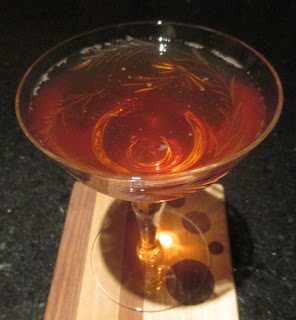1 1/2 oz Don Q Añejo Rum
3/4 oz Depaz Rhum Agricole
1/2 oz Rothman & Winter Apricot Liqueur
1/2 oz Green Tea Syrup (*)
1/2 oz Lime Juice
1 dash Angostura Bitters
12 drop St. George Absinthe
Shake with ice, strain into a Tiki mug, fill with crushed ice, and garnish with Tiki intent (freshly grated nutmeg and a paper umbrella).
(*) A strong 5 minute steep of green tea, remove tea leaves, mix in an equal part of sugar, and stir to dissolve.
On the Reddit's Cocktails forum, one of the moderators, Hebug, wrote me inquiring if I would like to help him with an event akin to Mixology Monday but more adapted to the Reddit structure than the blogging one. As a successor of Mixology Monday, I ended up dubbing this project Tipple Tuesday; it was a name that I had reserved in case Paul Clarke was unwilling to open up Mixology Monday after he had shelved the project himself. In the end, Paul opened up an account for me on the Mixology Monday site, and I was able to run it for a few dozen more events under that aegis.
For a starter event for Tipple Tuesday (click
here), I opted an experiment utilizing the
Mr. Potato Head technique where ingredients are swapped out for others (of similar style) while maintaining the drink skeleton intact. This technique is one that Phil Ward praises, and it has generated him drinks like the Oaxacan Old Fashioned and the Final Ward. As a Mr. Potato Head body for this event, I selected the
Test Pilot which has yielded me success in the past as a tinkering model with such drinks as the
Fiji Mermaid and the
Navigator.

For the major change, I honed in on the two sweeteners, triple sec and falernum, and swapped them for apricot liqueur and green tea syrup for I wanted to keep one fruit and one spice element (spice as in the classic punch theory where tea fulfilled that aspect). Perhaps this combination was inspired by the
Kobayashi Maru, but there were many drink thoughts going through my head around the same time. Since apricot pairs elegantly with rhum agricole such as in the
Rhum Agricot and
Abricot Vieux, I changed the lesser rum to rhum agricole and moved the original's light Puerto Rican rum to the larger volume one (replacing dark Jamaican rum).
For a name, I focused in on the tea element and named this after one of the famous 19th century British tea clipper ships, the Fiery Cross. Once prepared, the Fiery Cross greeted the nose with aromas of nutmeg and orchard fruit from the apricot and lime combination. Next, the lime and orchard fruit notes continued on into the sip, and the swallow offered the rum flavors and grassy tea merging with apricot with the absinthe's anise popping in on the finish.








 1 1/2 oz Appleton Estate Extra Rum (Denizen 8 Year)
1 1/2 oz Appleton Estate Extra Rum (Denizen 8 Year)






















 The 2017 collection of 855 drink recipes, bartender tributes, and essays on hospitality from CocktailVirgin's Frederic Yarm. Available at
The 2017 collection of 855 drink recipes, bartender tributes, and essays on hospitality from CocktailVirgin's Frederic Yarm. Available at  The 2012 collection of 505 drink recipes, techniques, and Boston bar recommendations from Frederic Yarm. Available at
The 2012 collection of 505 drink recipes, techniques, and Boston bar recommendations from Frederic Yarm. Available at 




